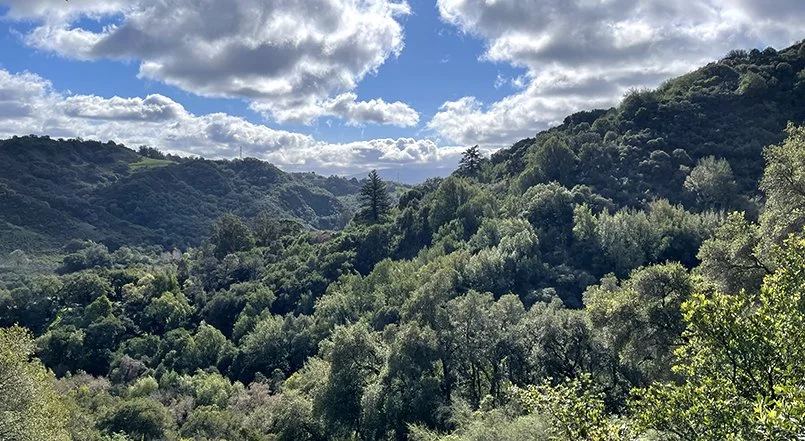As we celebrate Thanksgiving, SCVAS is celebrating several recent wins, and significant progress towards protections of birds, wildlife, and our environment.
We give thanks to the Santa Clara Valley Habitat Agency, for the purchase of Tulare Ridge – a critical Monarch and Bay Checkerspot butterfly habitat and wildlife linkage in South San Jose north of Coyote Valley.
Tulare Ridge, and the Coyote-Alamitos Canal that delineates it, form an important piece in the Coyote Valley landscape mosaic. The site is a gateway, framing the exit from the urban expanses of San Jose to the City’s largest conservation area, Coyote Valley. For five years, SCVAS has been fiercely fighting a proposed mansion and access road development on the Santa Teresa – Tulare Ridge along the Coyote-Alamitos Canal. Now we can say: we saved Tulare Ridge!
When we first saw the proposed development in early 2017, we expressed deep concern over the potential impacts to butterfly habitat and the curtailment of a critical wildlife linkage. Since then, with perseverance and tenacity, we worked with neighbors from the Los Paseos neighborhood, researched scientific documents, wrote letters, spoke at public meetings, advocated with San Jose City Council members, collaborated with other environmental groups, coordinated a wildlife-connectivity expert opinion, and even retained an attorney to ensure that San Jose was listening!
Bobcat with prey in the Coyote Alamitos Canal. Photo by Andrew Mattioda.
The ridge is mapped by the US Fish and Wildlife agency as Critical Habitat for the endangered Bay Checkerspot butterfly. Since we started opposing this development, Monarch butterflies and mountain lions have been declared candidates for listing as endangered species. Monarch butterflies will benefit from the abundance of their obligate host – Narrowleaf Milkweed - on the ridge. Bay checkerspot habitat can be enhanced and restored here to connect populations in Coyote Ridge to those in Santa Teresa Park. Mountain lions, always cautious of human activity, may benefit from the dark, uninhabited ridge leading to a safe under-crossing of Santa Teresa Blvd. Bobcats, foxes, deer and many other inhabitants of the ridge will continue to use the habitat, and to cross Santa Teresa Blvd safely.
We thank our partners in advocacy: the Sierra Club Loma Prieta Chapter, the Californian Native Plant Society, Santa Clara Valley Chapter, Green Foothills, and the many neighbors and friends who helped save Tulare Ridge.
We thank our panelists, partners and supporters who helped organize our symposium “Light at Night – a glowing hazard”, and the hundreds of people who attended.
The use of LED technology and energy saving lighting fixtures are bringing with them an unintended, yet pervasive and harmful effect: the over-lighting of our nights. On November 16, SCVAS, the Sierra Club Loma Prieta Chapter, and the Sierra Club Bay Alive Campaign presented a symposium to focus on the biological and physical effects of lighting up the night and to provide strategies that guard our health and environment while providing safe and practical lighting solutions.
Over 600 people registered for our symposium. After opening remarks from Assemblymember Alex Lee (D-24), the devastating impacts of light at night on birds, wildlife, and our ecosystems were presented by national experts:
Dr. John Barentine, Executive Officer and Principal Consultant at Dark Sky Consulting
Dr. Travis Longcore, Associate Adjunct Professor at the UCLA Institute of the Environment and Sustainability
Dr. Christine Sheppard, Director of the Glass Collisions Program at the American Bird Conservancy
Ms. Mary Coolidge, the BirdSafe & Lights Out Campaign Coordinator for Portland Audubon
Attendees, including elected officials, government representatives, professionals and members of the public, found the symposium informative and we received great reviews. You can watch the entire symposium here or check out the individual presentations linked to each of our presenter’s names.
We thank the Open Space Authority, Peninsula Open Space Trust, and the Santa Clara Valley Habitat Agency, which agreed to allocate 100-acres of habitat in Coyote Valley for the purpose of the Re-introduction of Western Burrowing Owls to Coyote Valley.
Burrowing Owl family. Photo by Tom Grey
The breeding Burrowing Owl population of the South San Francisco Bay Area is almost gone. In the past 6 years we lost 70% of the breeding adults – from 116 breeding adults in 2014 to only 33 adults in 2022. The owls have been extirpated from Mission College, Sunnyvale and the Warm Springs area, and have dwindled to almost none at the San Jose and Moffett airports. At present, local breeding populations persist solely due to intensive conservation efforts funded by the Santa Clara Valley Habitat Agency.
The Santa Clara Valley Audubon Society has been at the forefront of Burrowing Owl conservation over the past few decades. As we saw the population dwindle, we engaged in advocacy, monitoring and research. Currently, with funding from the Habitat Agency, we continue to engage in conservation efforts and the management of the Burrowing Owl population in Alviso, which in 2022 was the most successful and largest breeding population in the South San Francisco Bay Area.
We applaud the efforts of POST, the Habitat Agency, and the Santa Clara Valley Open Space Authority and hope that the conservation efforts you are jointly embarking on will return breeding Burrowing Owls to Coyote Valley.
We hope these efforts will be successful in recovering a breeding population of Burrowing Owls in the South Bay area.
We thank: Santa Clara County Supervisor Simitian, for the ongoing pressure on Lehigh Cement Plant in Cupertino. The first of three goals- closing the cement plant - has been achieved. We look forward to stopping all other environmentally harmful activities (such as rock grinding, mining and hauling) and to restoration and reclamation of the land.
Lastly, we must keep vigilant as threats are brewing for birds and open space.
Does “threat to Coyote Valley” sound familiar? It seems that every win is temporary. Now, efforts to expand greenhouses (and associated light pollution), mushroom growing facilities, battery farms and green energy infrastructure are, well - mushrooming in the valley. Please stay tuned for our action alerts.








